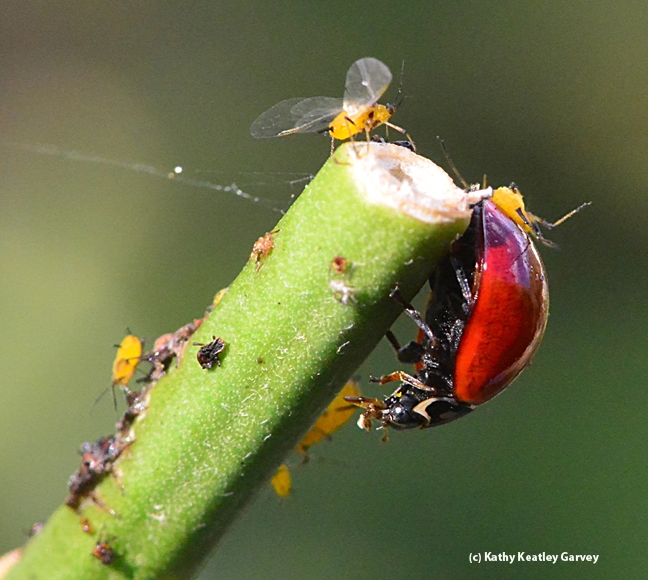Oleander aphids, those cartoonish-looking yellow insects with black legs and cornicles, are commonly found on oleanders. Hence their name. But they also are partial to milkweeds, the host plant of the monarch butterfly.
It's a daily challenge to rid those Draculalike pests from our milkweed plants. They pierce the tender stems and suck out the plant juices. Hey, do you mind? Those milkweeds are reserved for monarchs!
Fortunately, lady beetles, aka lady bugs, come to the rescue! Unfortunately, lady beetles also dine on monarch eggs.
It's a case of predator vs. prey (lady beetles vs. aphids) and beneficial insect vs. beneficial insect (lady beetles vs. monarch eggs).
Today something a little more unusual happened.
An oleander aphid hitched a ride on the back of a lady beetle. Apparently unaware of the hitchhiker (fast food at that!), the lady beetle kept gobbling up the aphid's relatives in an all-you-can-eat buffet.
We watched the lady beetle scurry up and down the mllkweed and then take off with the aphid securely on its back.
The lady beetle became the pilot, and the aphid, the passenger. The fair game became a free fare.
How do you control aphids on milkweed but still keep the monarch eggs?
An article appearing Nov. 9, 2012 in the Los Angeles Times had this to say:
"Monarch eggs are more tightly attached to leaves than aphids, so with just the right amount of pressure you may be able to wash off aphids without destroying the eggs.Sprayed water may only dislodge the pests, which can climb back up on their own or be returned by aphid-harvesting ants. Soapy water may dislodge and kill more aphids, but it also is more damaging to the monarchs and can build up on the plant."
"Though tedious, dabbing aphids with cotton swabs dipped in isopropyl (rubbing) alcohol is most effective. That kills them outright. Alcohol, however, also is lethal to monarch eggs and larvae, so care must be taken when dabbing."
For more about aphids, be sure to read the UC Statewide Integrated Pest Management's Pest Note. Be aware that aphids are not just sucking pests. They can also transmit viruses. "Squash, cucumber, pumpkin, melon, bean, potato, lettuce, beet, chard, and bok choy are crops that often have aphid-transmitted viruses associated with them. The viruses mottle, yellow, or curl leaves and stunt plant growth."
Attached Images:

A lady beetle picks up a hitchhiker, an oleander aphid. (Photo by Kathy Keatley Garvey)

One on the back and one in the mouth. (Photo by Kathy Keatley Garvey)

The oleander aphid maintains its hold on the back of its predator, a lady beetle. (Photo by Kathy Keatley Garvey)

The lady beetle prepares for take-off, with the oleander aphid still clinging to its back. (Photo by Kathy Keatley Garvey)